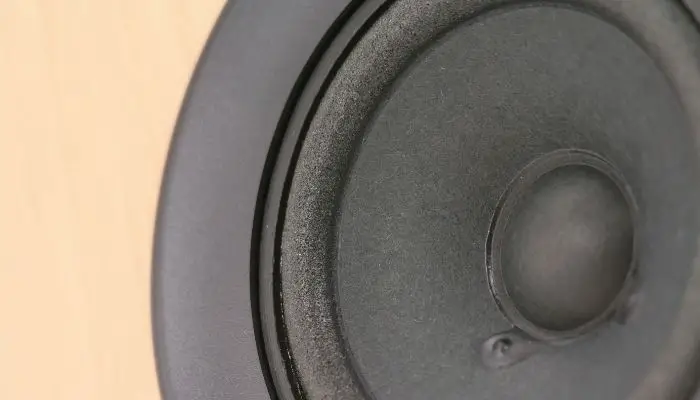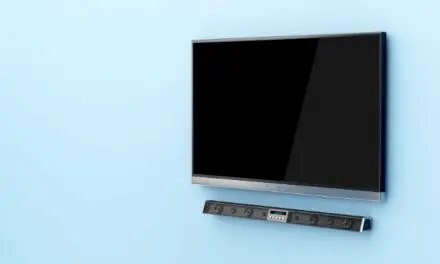When most people think of subwoofers, they think of the largest speaker in the set—the one that’s sitting on the floor so that the booming base doesn’t rattle everything that’s situated around it.
It also happens to be the most disregarded part of the speaker system and it’s not because it’s unappreciated. It’s simply because it’s the subwoofer. You set it up, plug it into everything else and then you leave it be.
The thing is, the positioning of a subwoofer is far more critical than you think, especially if you want to produce a true symbiosis between the subwoofer and the other speakers in your system.
Table of Contents
Can A Subwoofer Be Placed Up High?

A subwoofer can be placed up high and it usually sounds less boomy with a more balanced bass when positioned higher up. Just make sure that the sub is secured and nothing else around it can fall from the vibrations.
As it turns out, placing a subwoofer on the floor is just a simple matter of convenience. A subwoofer is generally the largest and heaviest of the speakers in a home theater setup. So, it’s just easier to keep the thing on the floor rather than purchasing or building a shelf that will support it.
It makes sense when you think about it, but you might not get everything out of the subwoofer that it has to offer if it’s on the floor rather than somewhere else. Most experts will tell you that the best place to install your subwoofer is in an elevated position unless your sub is underpowered, then on the floor, in the corner of a room may help to amplify it.
Unfortunately, a higher position for a large subwoofer is not always an easy thing to do. As we previously mentioned, a sub is usually the largest and heaviest speaker in the set. So finding a place for it isn’t always the easiest. Plus, due to the nature of what a subwoofer does, it needs an exceptionally stable position.
You don’t want to elevate it just anywhere either. Since it’s usually large, you want it to fit in with the overall aesthetic of the room while providing the deep, thrumming bass that creates richness within the overall sound effect.
But just because you have space up high on a sturdy shelf, it doesn’t mean your sub will sound good from up there.
The layout, construction, and placement of furniture within a room will dictate the location a sub will sound good from.
The only way you’ll really know is to test it out.
Consider doing a subwoofer crawl to find out if the place you plan to put your sub will deliver even and accurate bass. It can also help you to identify other locations where your subwoofer may sound even better.
First, place the subwoofer at the point where you will be listening from (as close to where your head will be as possible).
Next, walk, crawl and stand on chairs around your room until you find the positions where the subwoofer sounds best.
Lastly, place the subwoofer in one of those positions.
How High Should A Subwoofer Go?
The best elevation level for your subwoofer is level with your ears. That means you should look for ways to position it so that it is ear-level when you are seated on the couch, on your recliner, or on one of those gigantic bean bag things. Wherever it is that you sit, ear-level is perfect.
Of course, you have to do this while also compensating for any of the above-listed situations like furniture, windows, outlets, and more. The reason that it should be at ear level is because of how a subwoofer works.
Sound waves that come from a Subwoofer are low and therefore omnidirectional. You want to elevate them to ear level to maximize the use of the room and the vibrations from the sub. Floors typically have some level of soundproofing, whether that’s by design or incidental.
You may also find that you’ll get more even bass dispersion when you raise a sub off the floor. This is because the floor acts like a wall adding boundary gain and increasing boominess.
You may be losing a lot of what a subwoofer has to offer on the floor because the floor is taking it and all you get is a vibrating floor, especially if it’s a wood floor. The floor also tends to force the vibrations created by the subwoofer to intensify in a device that is already experiencing a lot of interior vibrations.
The acoustics of the room is another reason for elevating a subwoofer. You want to elevate your sub and try your best to center it. That way you get the best acoustical response in your room, with the omnidirectional soundwaves being free to actually be omnidirectional—up, down, left, right, forward, and backward.
Placed in a central location, you get the optimal base from all sides, without creating additional pressure on the subwoofer or allowing the sound waves to be absorbed into the floor or adjacent walls.
Related Article: Can A Subwoofer Interfere With Wifi? (Answered)
The Pros And Cons Of Putting A Subwoofer Up High
A subwoofer’s greatest enemy is a parallel surface. That means placement close to a wall, too close to the ceiling, or directly on the floor. While it’s not as significant a factor for the other speakers in your setup, your room layout and the acoustical qualities of the room are really important.
Placing your subwoofer in an elevated position, specifically at a level that is on or close to the level of your ears, is the best way to take advantage of what a sub has to offer. Of course, other elements of the room come into play as well, but that one, important factor comes first.
Unfortunately, there are some cons to placing a subwoofer at ear level, despite the advantages that it brings to the table in an elevated position.
| Pros | Cons |
| >You get the best acoustical qualities with elevation >No back pressure build-up >No sound absorption into the floor >Reduces conflicting sound waves >Improved “quality” bass | >It’s often difficult to center and elevate a large subwoofer >The power source has to be conveniently nearby |
How To Place A Subwoofer Up High
One of the hardest things that you have to deal with is trying to get a centrally focused, elevated subwoofer that also happens to be near a power outlet for convenience. Of course, there are wireless subwoofers but they are usually nowhere near as good.
To properly place a subwoofer, you also need to have some other, helpful conveniences going on in the room, such as window locations and furniture locations. It’s also best to keep a subwoofer at least 5” off the wall, which can be pretty hard considering the fact that you already need a large shelf to hold it up.
If you have a heavy, stable shelf, such as a bookshelf, you can give something like that a try to get you the elevation you need as well as help to keep the subwoofer from sitting flush with the wall.
An isolation pad will really help with this, to keep any kind of high-range vibration from knocking your subwoofer over or anything else that is sitting adjacent to it. Of course, it’s ideal to have the subwoofer alone on its shelf if possible.
Otherwise, you’re going to have to put together a large, stable shelf or purchase one. A sub doesn’t have to be perfectly centered in the room, but you want to get it as close as possible.
What Type Of Subwoofer Is Best For High Up?
Smaller bookshelf-type subwoofers that are between 8” and 12” are the best subwoofers for shelves and bookcases for obvious reasons. They are called “shelf” subwoofers after all. Also, for obvious reasons, tower subwoofers don’t really need any kind of shelf structure to stand on, even though you might want to elevate it a little bit.
Unless you have some serious hardware hanging from your walls, you’re not going to be able to hang very large subwoofers. However, you will be surprised at the increased richness of the bass from a 10” subwoofer that is properly located and elevated.
Final Thoughts
It’s a good idea to get your subwoofer up off the ground. You will improve the bass in almost every way. While sitting in a corner will make the bass louder, it won’t be quality bass. If you want to maximize the capabilities of your subwoofer, elevate it, keep it off the wall, and center it to the best of your ability.



